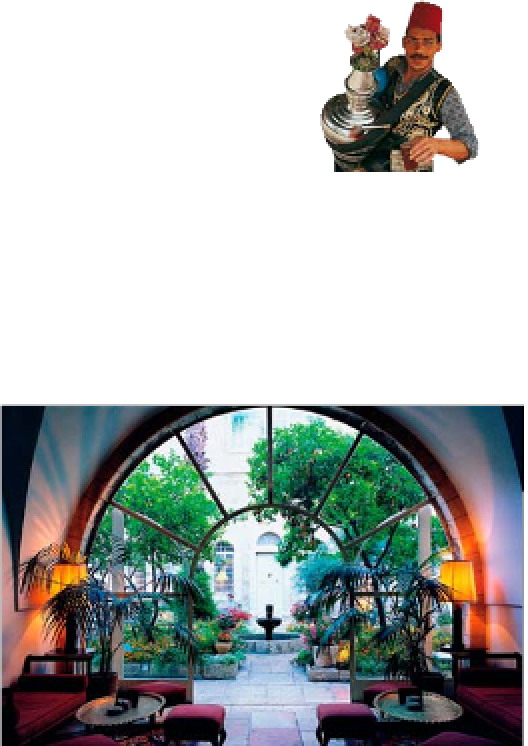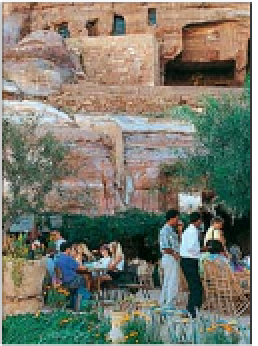Travel Reference
In-Depth Information
RESTAURANTS, CAFES AND BARS
M
iddle Eastern food i s often
Aside from the native cuisine, there
a re many other restaurants
offering more international food,
reflecting the broad ethnic mix
of the Holy Land. You can find
South American, Chinese,
Indonesian, Italian and French
food, along with the ever
popular American fast food.
There are also many busy and
informal cafés, which offer a cheaper,
more limited menu. For a quick snack,
street food revolves around the
shawarma
and
falafel
stalls, which can
overshadowed by other
more glamorous world
cuisine, and as such, the Holy
Land has been seen by many as
a gastronomic desert. Often
simple and unpretentious, the
food is, however, usually tasty and
substantial
(see pp268-9)
. A
constantly changing restaurant
culture reflects the huge interest in food
in the Holy Land, and many restaurants
are of a very high standard, offering a
wide range of Middle Eastern food sure
to excite even the most sceptical palate.
Vendor selling
the iced drink
tamahindi
l
be found almost everywhere.
cuisine of its own, Israeli food
is a melting pot of flavours,
reflecting the cultural mix of
the nation and adopting
influences from the Middle
East, the Mediterranean, and
Eastern Europe. The main
Israeli food is that of the Jews,
largely the Oriental (Middle
Eastern) and Ashkenazi
(eastern European) communi-
ties. Their food is as distinctly
different as their origins.
Oriental dishes revolve mainly
around grilled meats and fish,
stuffed vegetables, and a
range of
meze
. The Ashkenazi
specialities are spicy stews,
such as goulash, fish balls
and large, stuffed pancakes,
known as
blintzes
.
Other major ethnic groups
have also brought their own
unique and unusual dishes.
Armenian favourites include
spicy meat stews and sausages,
while the Yemenites are
famous for their
malawach
-
The restaurant in the Arabesque American Colony Hotel
(see p273)
PRACTICALITIES
and last day of Sukkoth and
Passover. In addition,
throughout Israel, all Jewish-
owned restaurants, whether
kosher or not, are closed on
Holocaust Day and
Remembrance Day
(see p36)
y
In most Israeli c
i
ties,
especially Tel Aviv and in
A
Jerusalem's Nakhalat Shiva
neighbourhood, you will see
people eating at all hours of
the day, seated outside at
cafés and restaurants or
walking along the street with
a pitta or
boureka
. In the
evening, people tend to eat
late, and spend a long time
over their meals. Eating is a
big social and family event,
with children accepted in
many restaurants. Dining,
when possible, is alfresco,
and restaurants often stay
open until after midnight,
especially during the summer.
However, restaurants are not
always open all week,
especially the Jewish ones.
These always close for
Shabbat (sundown on Friday
until after sundown on
Saturday), as well as for Yom
Kippur, Shavuot, and the first
.
Service is not generally
included on the bill, a fact
often well highlighted, and
you should expect to tip
around 10-15 %, depending
on the type of establishment.
Throughout Israel credit cards
are widely accepted, and
most of the restaurants listed
in this guide accept all the
major types.
TYPES OF RESTAURANT
Food is a major part of
Middle Eastern life, and
there is a huge range of
places to eat, from the trendy
and expensive city rest
a
urants
of Jerusalem and Tel Aviv to
A
the countless cheaper cafés
and take-aways. With no fixed
Dining outside in the spectacular
setting of Petra
(see pp220-31)












